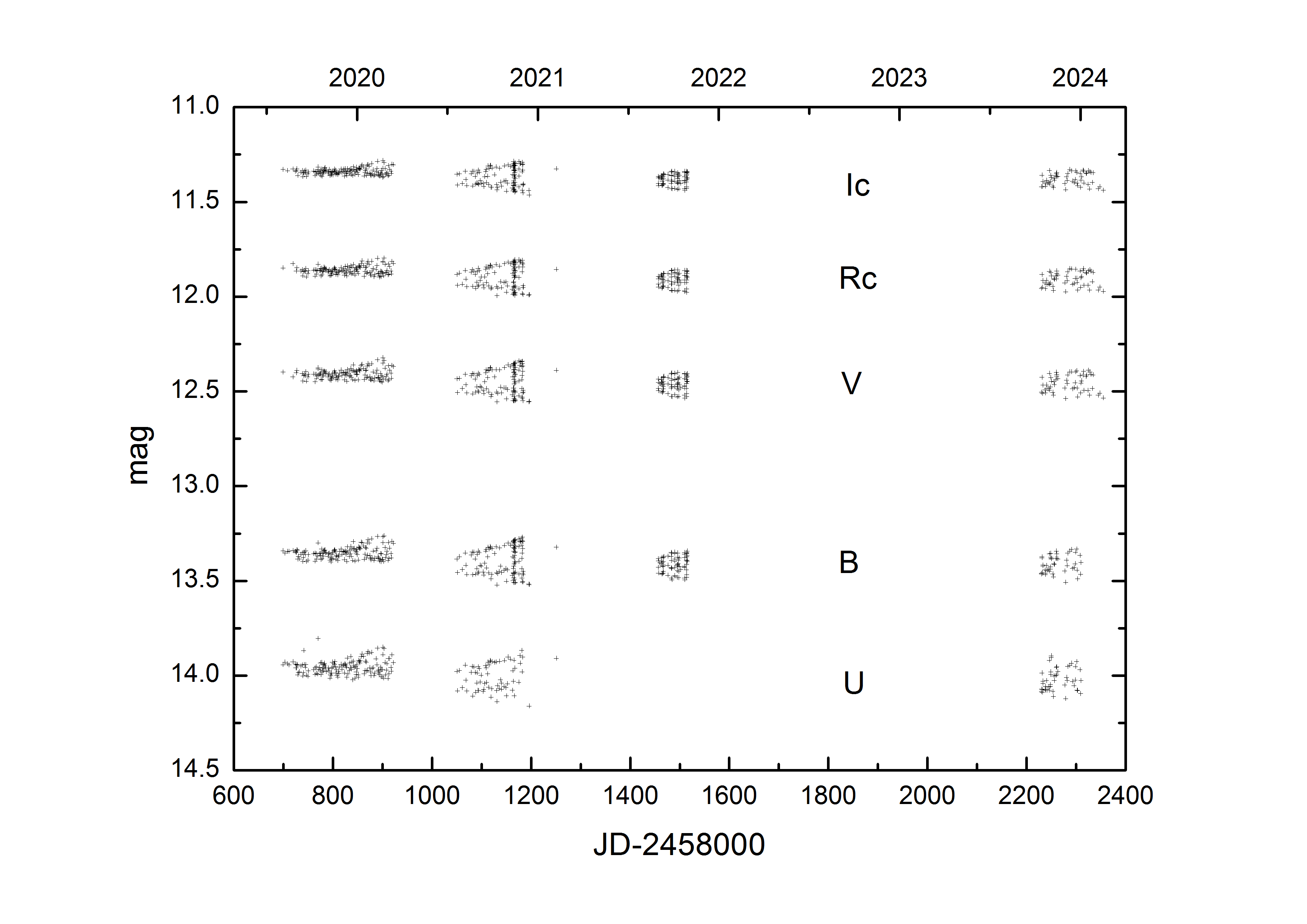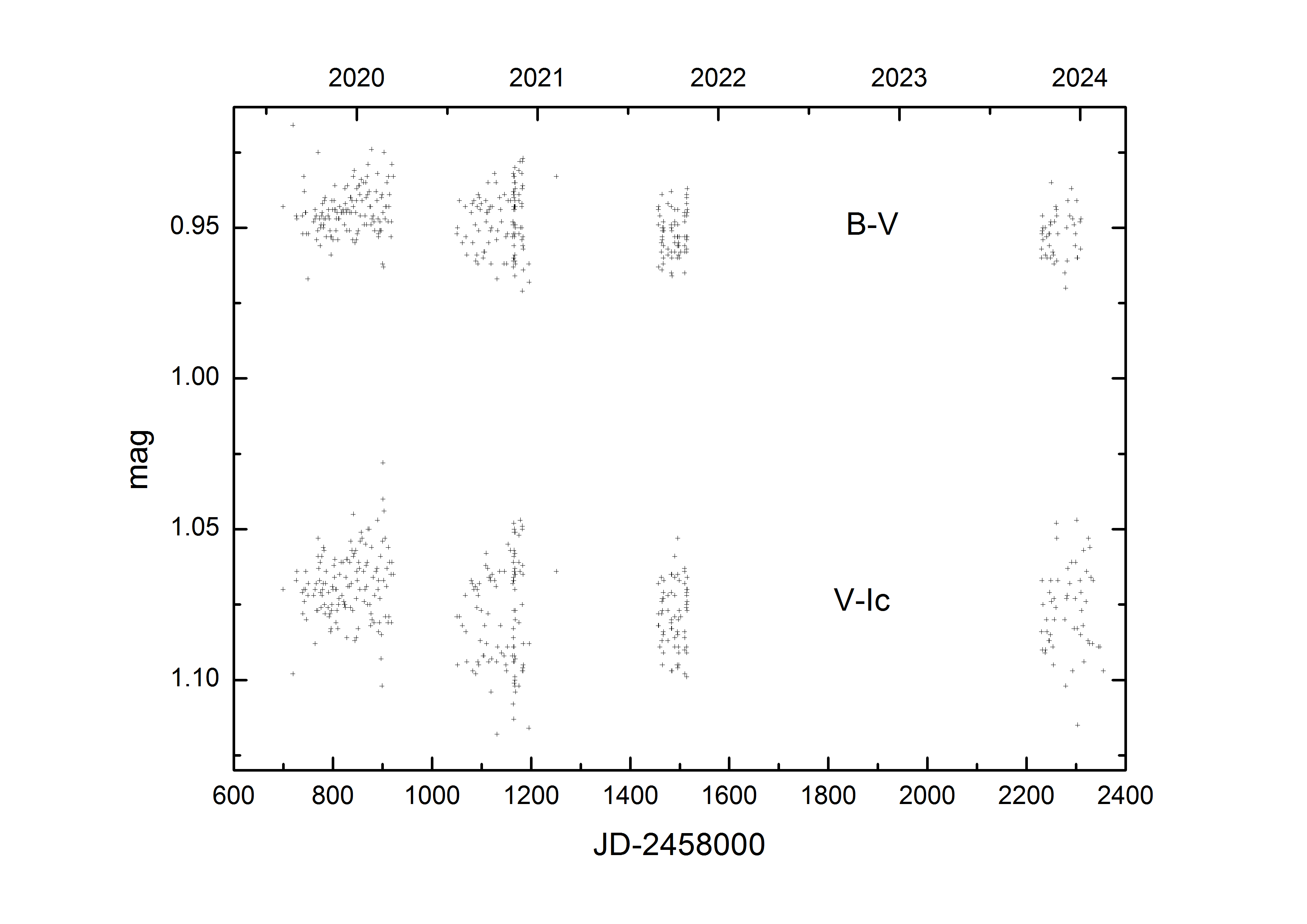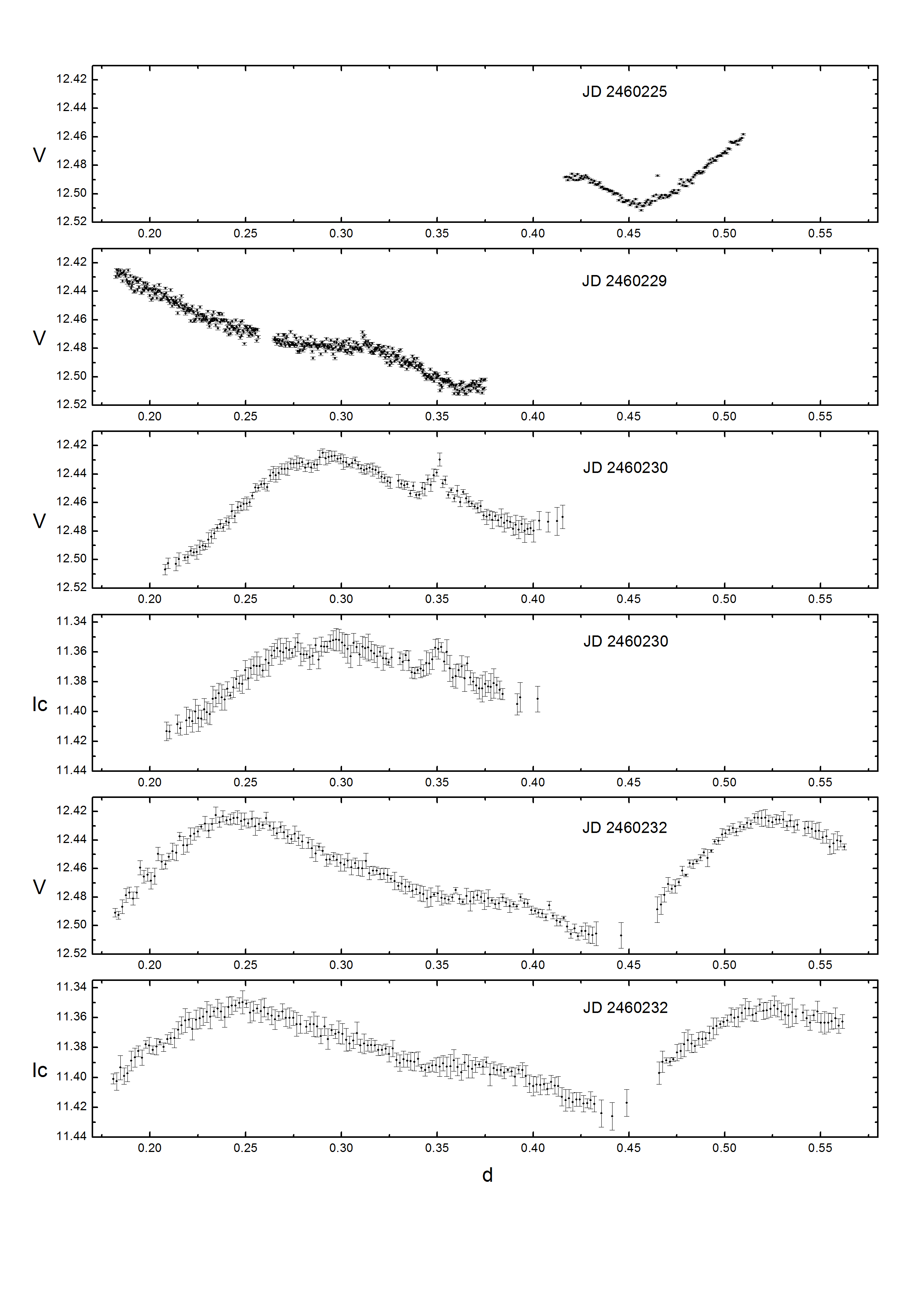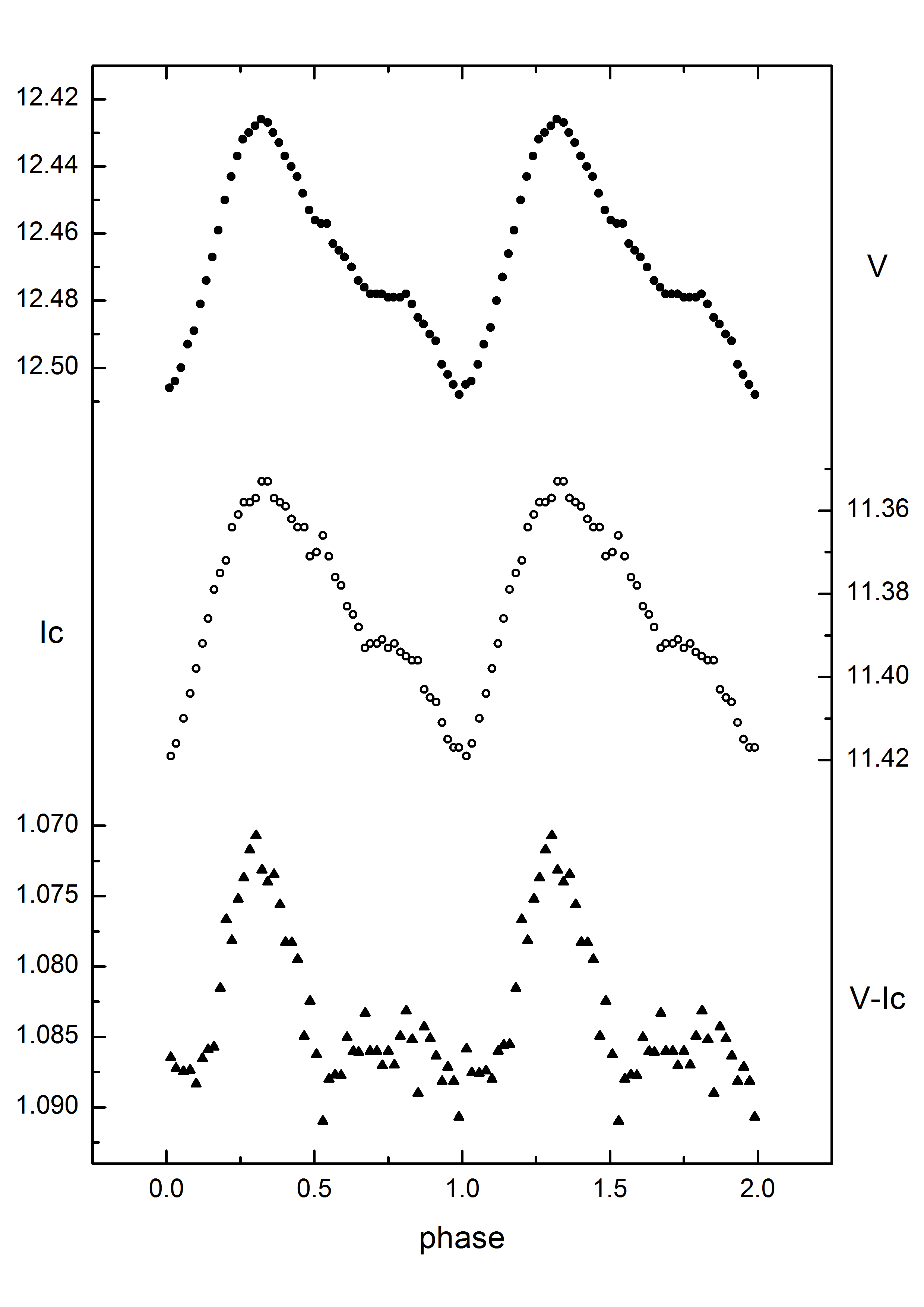|
Peremennye Zvezdy (Variable Stars) 45, No. 6, 2025 Received 8 February; accepted 3 March. |
Article in PDF |
|
DOI: 10.24412/2221-0474-2025-45-63-76
|
A Probable New BY Draconis Variable ZTFJ021857.72+585950.1
M. A. Burlak, N. P. Ikonnikova, A. V. Dodin, A. A. Belinski
Sternberg Astronomical Institute, Lomonosov Moscow State University, Universitetskij pr. 13, Moscow 119234, Russia
|
We present our analysis of new photometric and
spectroscopic data for a poorly studied star with an uncertain
variability type (BYDra or EW), ZTFJ021857.72+585950.1. The
observations were carried out with the 0.6-m and 2.5-m telescopes
of the Caucasian Mountain Observatory and the 1.25-m telescope of
the Crimean Astronomical Station of the Sternberg Astronomical
Institute (Lomonosov Moscow State University) in 2019-2024. We
found a period of 0 |
1. Introduction
In recent years, solar-like stars receive considerable attention in the light of exoplanet detection. On the one hand, solar-like stars are promising hosts of planets in the habitable zone. But on the other hand, some of these stars are known to be variable, which complicates the planet detection. The stellar activity in the case of solar-like stars is believed to be due to the interplay of convection and magnetic fields that results in the appearance of dark spots on the stellar photosphere. The number and size of spots are not constant, and their evolution, together with axial rotation, creates not strictly periodic photometric variations with relatively low amplitudes and a wide range of time scales (see, e.g., Strassmeier 2009 and references therein). A number of large photometric surveys, such as OGLE, ASAS-SN, ZTF among others, have provided us with light curves for many solar-like stars, and based on these data, several statistical studies have been carried out (e.g., Chen et al. 2020), but only few stars were examined individually.
In this paper, we present our study of the star
ZTFJ021857.72+585950.1 that demonstrates similar patterns of
variability. Miguel Muro Serrano was the first who announced the
variability of the source to AAVSO VSX based on his observations
carried out in December 2013. The star is included in the AAVSO
database under the name GSC03698-00538 with a period of
0![]() 2788975, initial epoch HJD 2456656.503, and phased light
curve based on Muro's observations, NSVS and APASS data. The type
of variability is given as
BY1.
In the ASAS-SN variable stars database, the star is named ASASSN-V
J021857.78+585950.3 and classified as ROT (rotational variable),
the period is not presented. The star is contained in the ZTF
Catalog as an eclipsing binary with a period of 0
2788975, initial epoch HJD 2456656.503, and phased light
curve based on Muro's observations, NSVS and APASS data. The type
of variability is given as
BY1.
In the ASAS-SN variable stars database, the star is named ASASSN-V
J021857.78+585950.3 and classified as ROT (rotational variable),
the period is not presented. The star is contained in the ZTF
Catalog as an eclipsing binary with a period of 0![]() 5579032. The
Simbad database also identifies the star as an eclipsing binary.
Thus, the type of variability is not well established so far. In
our study, we attempt to clarify the mechanism of the star's
variability and to determine its spectral type using our
multi-band photometry and spectroscopic observations. Hereafter,
we refer to the star as J0218+58.
5579032. The
Simbad database also identifies the star as an eclipsing binary.
Thus, the type of variability is not well established so far. In
our study, we attempt to clarify the mechanism of the star's
variability and to determine its spectral type using our
multi-band photometry and spectroscopic observations. Hereafter,
we refer to the star as J0218+58.
2. Observations and reductions
We carried out ![]() photometry with the 0.6-m telescope
(RC600) of the Caucasian Mountain Observatory (CMO) of Sternberg
Astronomical Institute, M.V. Lomonosov Moscow State University
(SAI MSU) in 2019-2024. The telescope is equipped with a set of
Johnson-Cousins
photometry with the 0.6-m telescope
(RC600) of the Caucasian Mountain Observatory (CMO) of Sternberg
Astronomical Institute, M.V. Lomonosov Moscow State University
(SAI MSU) in 2019-2024. The telescope is equipped with a set of
Johnson-Cousins ![]() filters and an Andor iKon-L BV camera
(2048
filters and an Andor iKon-L BV camera
(2048 ![]() 2048 pixels, the pixel size 13.5
2048 pixels, the pixel size 13.5![]() m; see
Berdnikov et al. 2020 for details). Initially, we took one set of
observations (2-3 frames in each band) per night, as our main
goal was to monitor the post-AGB candidate IRAS 02143+5852 with a
pulsation period of about 25
m; see
Berdnikov et al. 2020 for details). Initially, we took one set of
observations (2-3 frames in each band) per night, as our main
goal was to monitor the post-AGB candidate IRAS 02143+5852 with a
pulsation period of about 25![]() (Ikonnikova et al. 2024); the
star under study in the present paper drew our attention as a
variable object in the field: the scatter of magnitudes for the
star was larger than for other stars of similar brightness. We
were not able to deduce the type of the star's variability, but it
was clear that the possible period was shorter than 1
(Ikonnikova et al. 2024); the
star under study in the present paper drew our attention as a
variable object in the field: the scatter of magnitudes for the
star was larger than for other stars of similar brightness. We
were not able to deduce the type of the star's variability, but it
was clear that the possible period was shorter than 1![]() . Later,
we started to observe the star more frequently, several times a
night, which made it possible to derive its period and to make
some conclusions about the type of variability. All the
observational data were reduced in a standard way (debiasing,
darking, and flat-fielding) using the MAXIMDL5 package.
Then, aperture differential photometry was performed using a set
of three comparison stars. The primary comparison star (st1) was
selected in such a way as to minimize the photometric errors: the
magnitude and color difference between J0218+58 and st1 appeared
remarkably small. The other two stars were chosen to be a little
brighter and fainter, at least in the
. Later,
we started to observe the star more frequently, several times a
night, which made it possible to derive its period and to make
some conclusions about the type of variability. All the
observational data were reduced in a standard way (debiasing,
darking, and flat-fielding) using the MAXIMDL5 package.
Then, aperture differential photometry was performed using a set
of three comparison stars. The primary comparison star (st1) was
selected in such a way as to minimize the photometric errors: the
magnitude and color difference between J0218+58 and st1 appeared
remarkably small. The other two stars were chosen to be a little
brighter and fainter, at least in the ![]() band. The constancy of
the primary comparison star was monitored over the total time of
our observations, as shown in Fig. 1. The estimated errors in
differential magnitudes turned out to be
band. The constancy of
the primary comparison star was monitored over the total time of
our observations, as shown in Fig. 1. The estimated errors in
differential magnitudes turned out to be
![]() for the
for the
![]() bands,
respectively. The general information on the comparison stars is
presented in Table 1. We estimated the magnitudes of st1 using
successive observations of photometric standards in the S23-246
and S23-436 fields of Landolt (2013). The adopted values are
listed in Table 2.
bands,
respectively. The general information on the comparison stars is
presented in Table 1. We estimated the magnitudes of st1 using
successive observations of photometric standards in the S23-246
and S23-436 fields of Landolt (2013). The adopted values are
listed in Table 2.
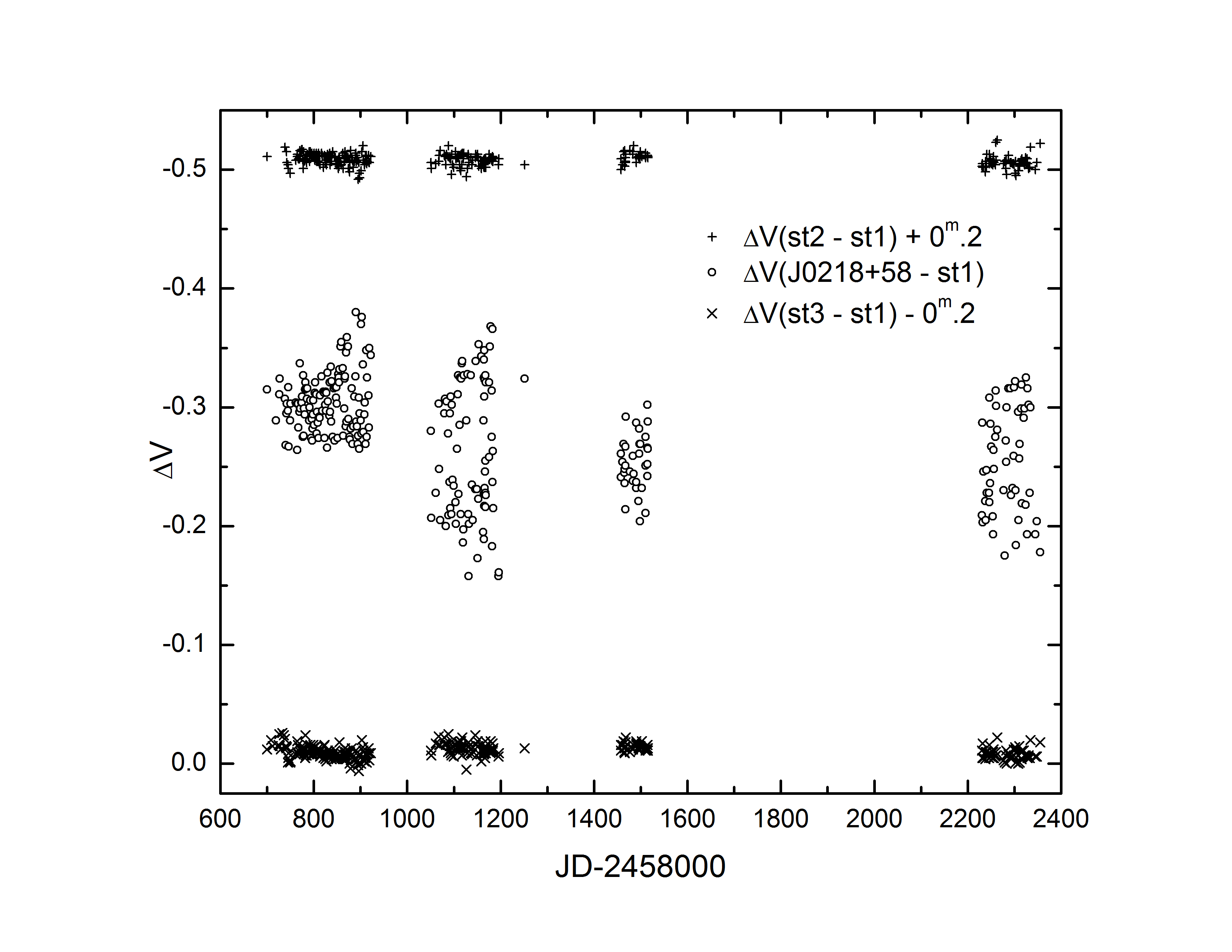 |
Fig. 1. The differential light curve for J0218+58 and secondary comparison stars (st2 and st3) with respect to the primary one (st1). The points are nightly average values. |
Our ![]() follow-up photometry was performed with the 1.25-m
telescope (ZTE) of the Crimean Astronomical Station (CAS) of SAI
MSU during four nights in October, 2023. A set of Asahi filters
was used together with an ASI6200MM Pro CMOS camera. The log of
observations and mean errors are presented in Table 3. St1 was
used as a primary comparison star. St2 and st3 were out of sight,
since the FoV of the detector was
follow-up photometry was performed with the 1.25-m
telescope (ZTE) of the Crimean Astronomical Station (CAS) of SAI
MSU during four nights in October, 2023. A set of Asahi filters
was used together with an ASI6200MM Pro CMOS camera. The log of
observations and mean errors are presented in Table 3. St1 was
used as a primary comparison star. St2 and st3 were out of sight,
since the FoV of the detector was
![]() . The
data were reduced in a similar way as the RC600 data. The
. The
data were reduced in a similar way as the RC600 data. The ![]() follow-up photometry was carried out as a part of test
observations aiming to check the tracking accuracy of the 1.25-m
telescope, so the weather conditions were different and sometimes
not quite good: observational errors in the last column of Table 3
differ from night to night. Besides, there are gaps in light
curves caused not only by worsening of atmospheric situation but
also by technical reasons.
follow-up photometry was carried out as a part of test
observations aiming to check the tracking accuracy of the 1.25-m
telescope, so the weather conditions were different and sometimes
not quite good: observational errors in the last column of Table 3
differ from night to night. Besides, there are gaps in light
curves caused not only by worsening of atmospheric situation but
also by technical reasons.
Our low-resolution spectroscopic observations of J0218+58 were carried out with the TDS spectrograph mounted on the 2.5-m CMO telescope (see Potanin et al. 2020 for the description of TDS and reduction procedures). The log of observations is presented in Table 4.
3. Seasonal light and color curves
In Figs. 2 and 3, we show the ![]() light and
light and ![]() ,
, ![]() color curves based on the RC600 photometry. Each point
represents an average of several estimates obtained during one set
of observations. Such sets were usually performed once a night,
but there were also nights with several sets separated by about an
hour. These nights can be distinguished by concentrations of
points in Fig. 2. It is clearly seen that the mean seasonal
brightness of J0218+58 was not constant during the entire time
interval of our observations. An especially drastic change
occurred between March and July, 2020: the star faded by
color curves based on the RC600 photometry. Each point
represents an average of several estimates obtained during one set
of observations. Such sets were usually performed once a night,
but there were also nights with several sets separated by about an
hour. These nights can be distinguished by concentrations of
points in Fig. 2. It is clearly seen that the mean seasonal
brightness of J0218+58 was not constant during the entire time
interval of our observations. An especially drastic change
occurred between March and July, 2020: the star faded by
![]() in all bands. Besides, the amplitude of light
variations was also not constant: it was the smallest during the
2019-2020 season and the largest, in 2020-2021. It should be
also mentioned that the maximum variation is the largest in the
in all bands. Besides, the amplitude of light
variations was also not constant: it was the smallest during the
2019-2020 season and the largest, in 2020-2021. It should be
also mentioned that the maximum variation is the largest in the
![]() band and gradually decreases to the
band and gradually decreases to the ![]() band. The
peak-to-peak amplitude can change on a time scale of several
months. The seasonal mean brightness and maximum variation in the
band. The
peak-to-peak amplitude can change on a time scale of several
months. The seasonal mean brightness and maximum variation in the
![]() bands are presented in Table 5. A mean
brightness-amplitude correlation is seen: the star varies
stronger (although the observed variation was never larger than
bands are presented in Table 5. A mean
brightness-amplitude correlation is seen: the star varies
stronger (although the observed variation was never larger than
![]() ) when it is, on average, fainter and redder. The
color variation is larger at longer wavelengths. The fact that the
star tends to be redder when fainter, as can be seen from the
color-magnitude diagrams presented in Fig. 4, implies temperature
variations. On this point, we can suspect that the variability of
J0218+58 is caused by axial rotation of a star with non-uniformly
distributed and time-variable dark spots on its surface.
) when it is, on average, fainter and redder. The
color variation is larger at longer wavelengths. The fact that the
star tends to be redder when fainter, as can be seen from the
color-magnitude diagrams presented in Fig. 4, implies temperature
variations. On this point, we can suspect that the variability of
J0218+58 is caused by axial rotation of a star with non-uniformly
distributed and time-variable dark spots on its surface.
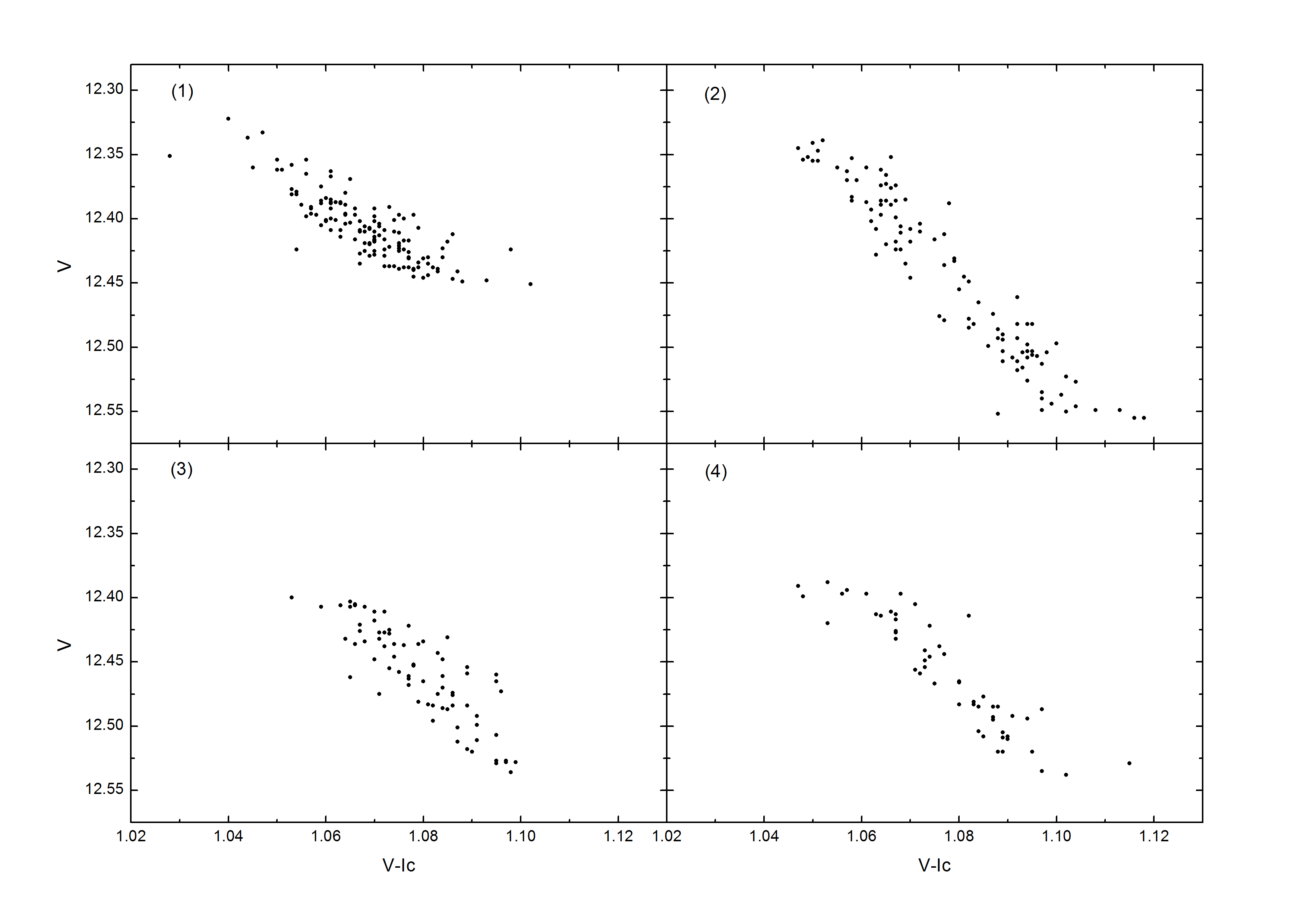 |
Fig. 4. The color-magnitude diagrams based on RC600 observations for different seasons marked by numbers (1)-(4) according to Table 4. |
| ID | Star | Reference | ||
| TYC 3698-296-1 | st1 | 13.51 | 11.67 | Høg et al. (2000) |
| UCAC4 746-021760 | st2 | 12.64 | 11.99 | Zacharias et al.(2013) |
| Gaia DR3 459181142673740416 | st3 | - | - | Gaia Collaboration (2022) |
| 14.245 | 0.009 | 13.649 | 0.010 | 12.713 | 0.006 | 12.198 | 0.004 | 11.715 | 0.010 |
| Season | |
|
|
|
|
|
|
|
|
|
| (1) Aug 2019-Mar 2020 | 13.96 | 0.22 | 13.35 | 0.14 | 12.41 | 0.13 | 11.86 | 0.10 | 11.34 | 0.09 |
| (2) Jul 2020-Feb 2021 | 14.01 | 0.29 | 13.39 | 0.25 | 12.45 | 0.22 | 11.90 | 0.19 | 11.37 | 0.18 |
| (3) Aug 2021-Oct 2021 | - | - | 13.41 | 0.15 | 12.46 | 0.14 | 11.91 | 0.12 | 11.38 | 0.10 |
| (4) Oct 2023-Feb 2024 | 14.02 | 0.22 | 13.41 | 0.17 | 12.46 | 0.15 | 11.91 | 0.12 | 11.38 | 0.11 |
4. Search for periodicity
Aiming to derive the period for J0218+58 and having in mind that
the amplitude (and likely phase) of light variation is variable,
we constrained ourselves to two time-limited intervals:
JD2459164-2459196 (32![]() duration ) and JD2459483-2459515
(32
duration ) and JD2459483-2459515
(32![]() duration) that include sequences of nights when the star
was observed more than once in the sense discussed in the previous
section (several sets of 2-3 frames during one night). Then,
using several statistical methods, namely, those of
Lafler-Kinman, Barning, Renson, and the string method (our
self-developed Python implementation of these methods is based on
Terebizh 1992), a period of 0.279
duration) that include sequences of nights when the star
was observed more than once in the sense discussed in the previous
section (several sets of 2-3 frames during one night). Then,
using several statistical methods, namely, those of
Lafler-Kinman, Barning, Renson, and the string method (our
self-developed Python implementation of these methods is based on
Terebizh 1992), a period of 0.279![]() was found independently for
each interval, and it was the same for the
was found independently for
each interval, and it was the same for the ![]() and
and ![]() bands. We
failed to derive the period based on the whole set or seasonal
intervals of observations, but, with the derived period, we were
able to fold light variation in any not too long time interval.
In Fig. 5, all the acquired RC600
bands. We
failed to derive the period based on the whole set or seasonal
intervals of observations, but, with the derived period, we were
able to fold light variation in any not too long time interval.
In Fig. 5, all the acquired RC600 ![]() data are shown folded with
this period. The red points correspond to the intervals used to
determine the period for seasons (2) and (3) according to Table 5.
The red points in season (1) correspond to the interval
JD 2458870-2458922 that was not used in determining the period,
they are highlighted just to illustrate the fact that the phase of
minimum light is not constant, it can change on a time-scale of
several tens of days or less. The pattern of light variation is
also not constant: sometimes the rising branch is steeper,
sometimes the falling one is steeper, and sometimes they are
similar. The larger the amplitude, the longer time the pattern
persists. The period did not vary, if it was at least detectable,
during the entire time of our observations. Thus, we can state
that the period is a rotational one and that variations of the
light curve are probably due to evolution and migration of spots
on the surface of a rotating star.
data are shown folded with
this period. The red points correspond to the intervals used to
determine the period for seasons (2) and (3) according to Table 5.
The red points in season (1) correspond to the interval
JD 2458870-2458922 that was not used in determining the period,
they are highlighted just to illustrate the fact that the phase of
minimum light is not constant, it can change on a time-scale of
several tens of days or less. The pattern of light variation is
also not constant: sometimes the rising branch is steeper,
sometimes the falling one is steeper, and sometimes they are
similar. The larger the amplitude, the longer time the pattern
persists. The period did not vary, if it was at least detectable,
during the entire time of our observations. Thus, we can state
that the period is a rotational one and that variations of the
light curve are probably due to evolution and migration of spots
on the surface of a rotating star.
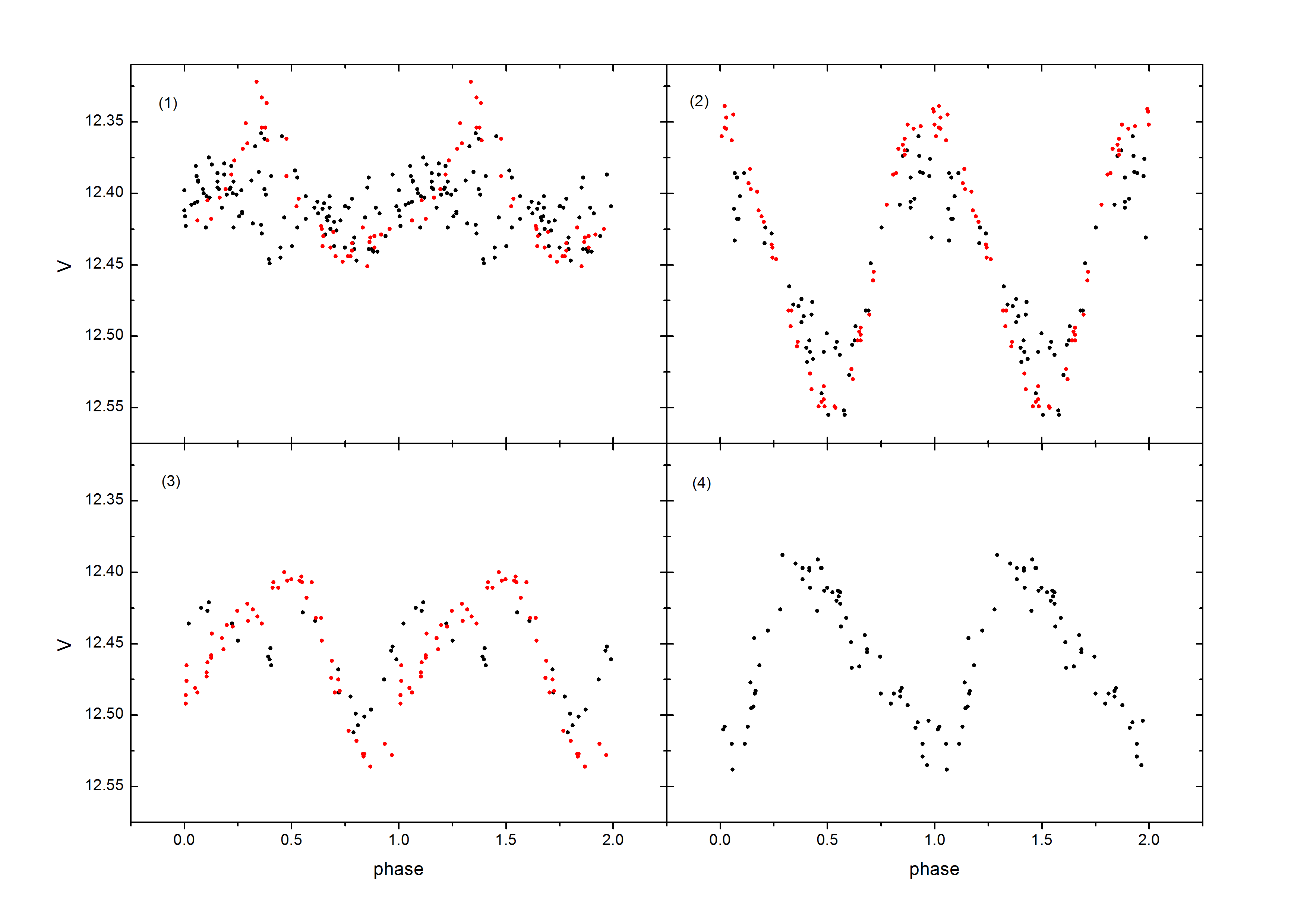 |
Fig. 5.
Phased |
5.  follow-up photometry
follow-up photometry
The ![]() and
and ![]() light curves (or their parts) are similar in
shape, with the
light curves (or their parts) are similar in
shape, with the ![]() peak-to-peak amplitude being a little larger
(Fig. 6). On JD 2460229, there is a short
peak-to-peak amplitude being a little larger
(Fig. 6). On JD 2460229, there is a short
![]() brightening by
brightening by
![]() in the descending branch of both
light curves, which is not seen on JD 2460229 or JD 2460232,
though the overall pattern of light variations remains the same
during the time interval of observations. We consider this fact as
an evidence for sporadic short-timescale flare-like variations of
J0218+58. In Fig. 7, we present the
in the descending branch of both
light curves, which is not seen on JD 2460229 or JD 2460232,
though the overall pattern of light variations remains the same
during the time interval of observations. We consider this fact as
an evidence for sporadic short-timescale flare-like variations of
J0218+58. In Fig. 7, we present the ![]() phased light curves
folded with the period of
phased light curves
folded with the period of
![]() and then averaged over four
observing nights with a step of 0.02 of the period to obtain the
and then averaged over four
observing nights with a step of 0.02 of the period to obtain the
![]() phased color curve that shows the object to be bluer when
brighter. It is worth mentioning that the
phased color curve that shows the object to be bluer when
brighter. It is worth mentioning that the ![]() phased light curve
observed in October, 2023 looks like that obtained by Muro in
December, 2013, with quite the same average magnitude but with the
ascending and descending branches switched.
phased light curve
observed in October, 2023 looks like that obtained by Muro in
December, 2013, with quite the same average magnitude but with the
ascending and descending branches switched.
6. Spectra
Because of the low spectral resolution of our TDS spectra, we do
not attempt to derive
![]() , or [Fe/H] for
J0218+58. Comparing our spectra to high-resolution spectra of Gaia
benchmark stars (Strassmeier et al. 2018) downgraded to the
spectral resolution of the TDS spectra, we can state that J0218+58
is an early K dwarf with more or less evident emission filling the
hydrogen and CaII H and K lines. Spectral features used in
temperature classification were selected following the
recommendation of Gray and Corbally (2009) and are marked in
Fig. 8, with the ratio CrI
, or [Fe/H] for
J0218+58. Comparing our spectra to high-resolution spectra of Gaia
benchmark stars (Strassmeier et al. 2018) downgraded to the
spectral resolution of the TDS spectra, we can state that J0218+58
is an early K dwarf with more or less evident emission filling the
hydrogen and CaII H and K lines. Spectral features used in
temperature classification were selected following the
recommendation of Gray and Corbally (2009) and are marked in
Fig. 8, with the ratio CrI![]() /FeI
/FeI![]() ,
,
![]() being the most reliable since it is insensitive to
metallicity. It should be mentioned that
being the most reliable since it is insensitive to
metallicity. It should be mentioned that ![]() Eri and
61CygA whose spectra are shown in Fig. 8 are BYDraconis
variables (Samus et al. 2017).
Eri and
61CygA whose spectra are shown in Fig. 8 are BYDraconis
variables (Samus et al. 2017).
We did not find any significant variation in the emission in the
CaII H and K lines: it never extended above the surrounding
pseudo-continuum (Fig. 8). But we did detect a variation in the
H![]() profile. Not only the nightly average H
profile. Not only the nightly average H![]() profile
differs from night to night, but sometimes there are also changes
within one night (Fig. 9). Unfortunately, the spectroscopic
observations were not synchronized with the photometric ones, so
we cannot specify the phase of photometric activity for the time
when the spectra were taken, the phase being not constant.
profile
differs from night to night, but sometimes there are also changes
within one night (Fig. 9). Unfortunately, the spectroscopic
observations were not synchronized with the photometric ones, so
we cannot specify the phase of photometric activity for the time
when the spectra were taken, the phase being not constant.
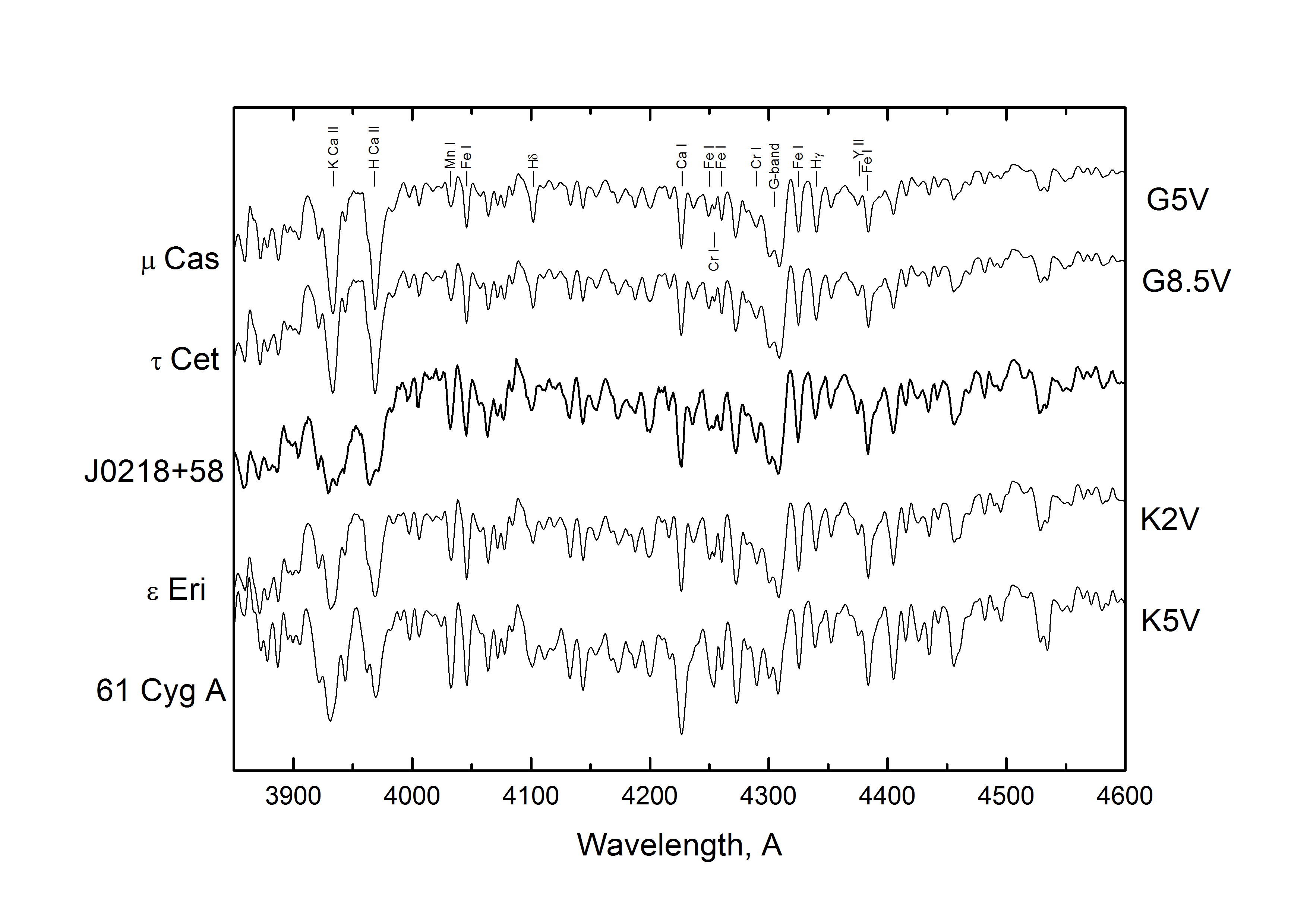 |
Fig. 8. Normalized TDS spectrum of J0218+58 obtained on 2022-03-14 shown along with a temperature sequence for late G - early K dwarfs. The spectra were taken from Strassmeier et al. (2018) and vertically offset. |
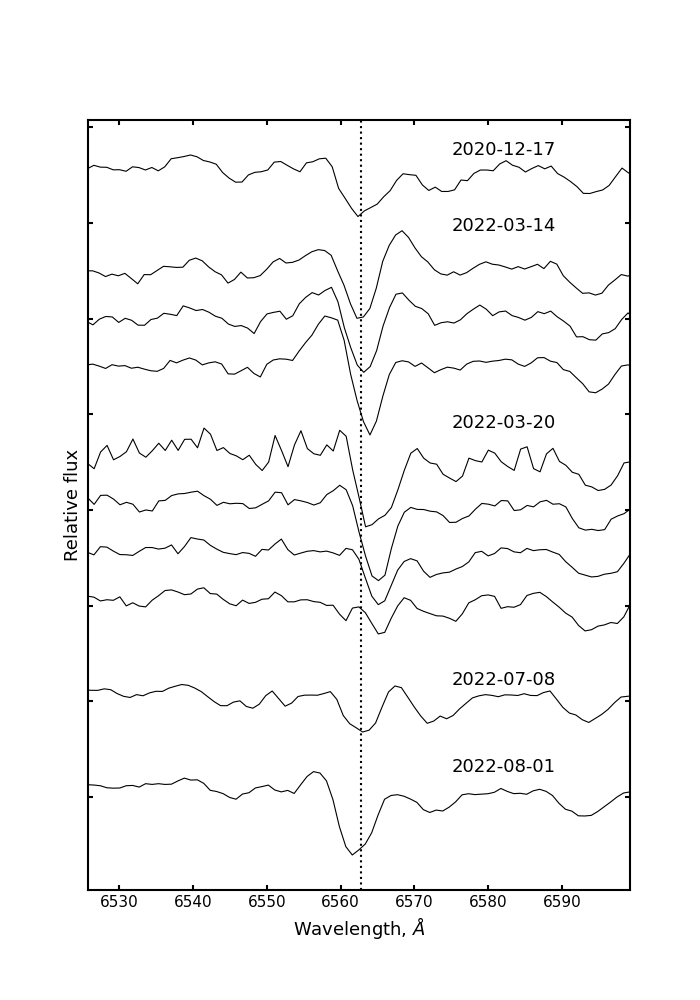 |
Fig. 9.
Variation of the H |
7. Interstellar extinction and distance
If we take the mean brightness estimates for season (1) (Table 5)
when the star was relatively bright and, therefore, mostly free of
spots (if we consider J0218+58 a BYDra-type star), and adopt the
ZAMS color index and
![]() for K1V stars from
Straizys (1992), then the dereddened colors appear to be
for K1V stars from
Straizys (1992), then the dereddened colors appear to be
![]() and
and ![]() , which corresponds to a K1 main
sequence star. The color excess is then
, which corresponds to a K1 main
sequence star. The color excess is then ![]() , and the
interstellar extinction is
, and the
interstellar extinction is ![]() . Assuming the Straizys
(1992) calibration of absolute magnitudes, we have
. Assuming the Straizys
(1992) calibration of absolute magnitudes, we have
![]() for a K1V star, and then the distance to J0218+58 is 154 pc.
for a K1V star, and then the distance to J0218+58 is 154 pc.
According to the Gaia Data Release 3 (Gaia collaboration 2022;
Gaia DR3), the distance to J0218+58 is 161.5 pc
(
![]() mas with RUWE=0.806), which is in excellent
agreement with our estimate. Besides, Gaia DR3 provides the
following parameters for the star:
mas with RUWE=0.806), which is in excellent
agreement with our estimate. Besides, Gaia DR3 provides the
following parameters for the star:
![]() K,
K, ![]() , [Fe/H]=-0.2,
, [Fe/H]=-0.2, ![]() ,
, ![]() ,
,
![]() , and the age of 0.448 Gyr.
, and the age of 0.448 Gyr.
It is worth mentioning that Foster et al. (2000) considered the
star a member of the open cluster Stock 2 with membership
probability ![]() % based on its proper motion. However, the
adopted cluster distance of
% based on its proper motion. However, the
adopted cluster distance of ![]() pc is too large for
J0218+58 to be a member.
pc is too large for
J0218+58 to be a member.
8. Discussion
The emissions in the cores of the H![]() , CaII H and K lines
are indicative of chromospheric activity (Gray et al. 2003) caused
by the stellar magnetic field that is believed to be closely
linked to stellar rotation and to weaken with age. According to
the study by Chen et al. (2020) based on the ZTF Data Release 2,
the rotational periods of BY Dra variables range from 0.25 to 20
days. Thus, the rotational period of
, CaII H and K lines
are indicative of chromospheric activity (Gray et al. 2003) caused
by the stellar magnetic field that is believed to be closely
linked to stellar rotation and to weaken with age. According to
the study by Chen et al. (2020) based on the ZTF Data Release 2,
the rotational periods of BY Dra variables range from 0.25 to 20
days. Thus, the rotational period of
![]() places J0218+58
among the youngest known BYDra-type variables, where the
spin-down effect has not yet occurred. However, it is worth
mentioning that Chen et al. (2020) classified J0218+58 as a
contact (EW type) eclipsing binary with
places J0218+58
among the youngest known BYDra-type variables, where the
spin-down effect has not yet occurred. However, it is worth
mentioning that Chen et al. (2020) classified J0218+58 as a
contact (EW type) eclipsing binary with
![]() , a period
twice longer than that derived in this study. We suppose that the
wrong classification of J0218+58 by Chen et al. (2020) is the
result of a combination of the non-constancy of amplitude and
phase of J0218+58 with the low sampling (one observation per
night) of the ZTF observing routine. Anyway, Fig. 5 demonstrates
that the light curve of J0218+58 resembles those of eclipsing
binaries only sometimes.
, a period
twice longer than that derived in this study. We suppose that the
wrong classification of J0218+58 by Chen et al. (2020) is the
result of a combination of the non-constancy of amplitude and
phase of J0218+58 with the low sampling (one observation per
night) of the ZTF observing routine. Anyway, Fig. 5 demonstrates
that the light curve of J0218+58 resembles those of eclipsing
binaries only sometimes.
9. Conclusions
J0218+58 displays light variations with a range of amplitudes,
varying in ![]() from
from
![]() to
to
![]() , and a period of
0
, and a period of
0![]() 279 (6
279 (6![]() 7). To our knowledge, we are the first to classify
J0218+58 as a K1V star and to detect profile variations of the
H
7). To our knowledge, we are the first to classify
J0218+58 as a K1V star and to detect profile variations of the
H![]() line both from night to night and during one night. We
have estimated the interstellar extinction
line both from night to night and during one night. We
have estimated the interstellar extinction ![]() and the
distance to the star
and the
distance to the star ![]() pc. The observed features of
J0218+58 strongly favor the idea that it is a BYDra-type
variable and its variations are a result of rotation and
nonuniform surface brightness due to dark spots. The
classification of the star as an eclipsing binary given in the
Simbad database should be revised.
pc. The observed features of
J0218+58 strongly favor the idea that it is a BYDra-type
variable and its variations are a result of rotation and
nonuniform surface brightness due to dark spots. The
classification of the star as an eclipsing binary given in the
Simbad database should be revised.
Acknowledgements
We are very grateful to the CMO staff for maintaining the equipment and assisting in observations. We thank visiting observers N. A. Maslennikova, B. S. Safonov, S. G. Zheltoukhov, V. Y. Lander who obtained the TDS spectra. We have made use of the Simbad database and NASA's Astrophysical Data System. The study was conducted under the state assignment of Lomonosov Moscow State University.
References:
Berdnikov, L. N., Belinskii, A. A., Shatskii, N.I., et al. 2020, Astron. Rep., 64, No. 4, 310
Chen, X., Wang, S., Deng, L., et al. 2020, Astrophys. J., Suppl. Ser., 249, No. 1, article id. 18
Foster, D. C., Theissen, A., Butler, C. J., et al. 2000, Astron. & Astrophys., Suppl. Ser., 143, No. 3, 409
Gaia Collaboration 2022, VizieR On-line Data Catalog: I/355
Gray, R. O., Corbally, C. J., Garrison, R. F. et al. 2003, Astron. J, 126, No. 4, 2048
Gray, R. O. & Corbally, C. J. 2009, Stellar Spectral Classification, Princeton University Press
Høg, E., Fabricius, C., Makarov, V. V., et al. 2000, Astron. & Astrophys., 355, No. 2, L27
Ikonnikova, N. P., Burlak, M. A., Dodin, A. V., et al. 2024, Monthly Notices Roy. Astron. Soc., 530, No. 2, 1328
Landolt, A. U. 2013, Astron. J, 146, No. 5, 131
Potanin, S. A., Belinski, A. A., Dodin, A. V., et al. 2020, Astron. Lett., 46, No. 12, 836
Samus, N. N., Kazarovets, E. V., Durlevich, O. V., et al. 2017, Astron. Rep., 61, No. 1, 80
Straizys V., 1992, Multicolor stellar photometry, Tucson: Pachart Publ. House
Strassmeier, K. G. 2009, Astron. & Astrophys. Rev., 17, No. 3, 251
Strassmeier, K. G., Ilyin, I., & Weber, M. 2018, Astron. & Astrophys., 612, article id. A45
Terebizh, V. Iu. 1992, Analiz vremennykh riadov v astrofizike (Analysis of Time Series in Astrophysics), Moscow: Nauka Fiz.-Mat. (in Russian)
Zacharias, N., Finch, C. T., Girard, T. M., et al. 2013, Astron. J, 145, No. 2, article id. 44
